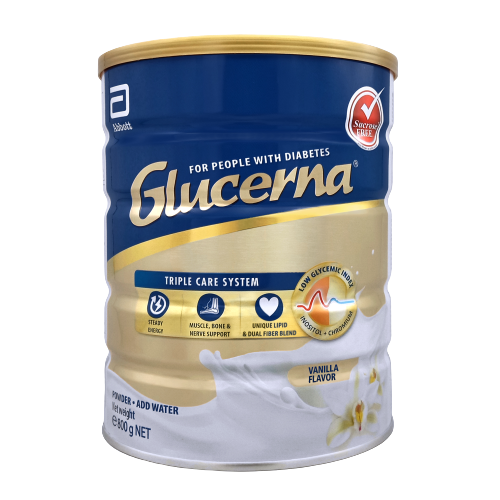Glucerna triple care
- Main Image
-

- Subtitle
- Complete and Balanced Nutrition For People with Diabetes
- Title
- Glucerna® Triple Care
- Detail Page Path
Glycemic Index is the ranking of carbohydrates in foods according to how much they affect blood glucose levels. There are many factors contributing to the GI of a food, including the type of carbohydrate, fat content, processing and digestibility.
High GI foods elevate blood sugar levels more rapidly and to a greater extent than low GI foods. For instance, mashed potatoes are a high GI food and eating them makes blood sugar rise a lot. Beans are a low GI food and eating them causes only a small change in blood sugar.
Foods have been divided into categories based on their Glycemic Index values and classified as low GI, intermediate GI and high GI.
| Glycemix Index Range | |
|---|---|
| Low GI ≤ 55 | Slower and lower rise in blood sugar levels |
| Intermediate GI 56-69 | Moderate rise in blood sugar levels |
| High GI ≥ 70 | Fast rise in blood sugar levels |
A low GI diet can help control blood sugar levels in people with diabetes, helps with weight management, makes you feel full for a longer period of time, improves blood cholesterol profiles and may improve the body’s sensitivity to insulin.
Glycemic Index of Selected Foods. (Glucose = 100)
| Food | GI Value |
| Low ≤ 55 | |
| Peanuts | 14 |
| Raw carrots | 16 |
| Cashew nuts | 22 |
| Kidney beans | 28 |
| Similac® Mum | 28 |
| Glucerna® Triple Care Powder | 31 |
| Apple | 38 |
| Strawberries | 40 |
| Milk, full fat | 40 |
| Green Peas | 48 |
| Intermediate 55-69 | |
| Brown rice | 55 |
| Wholegrain bread | 59 |
| Corn | 60 |
| Spaghetti | 61 |
| Croissant | 67 |
| High ≥ 70 | |
| Parboiled rice | 72 |
| Mashed potato | 74 |
| Baked potato | 85 |
| Cornflakes | 92 |
| Baguette | 95 |
References:
Foster-Powell et al. International table of glycemic index and glycemic load values. Am J Clin Nutr 2002; 76:5-56.
SG.2022.29988.GLU.1 (V1.1)
You are about to exit for another Abbott country or region specific website.
Please be aware that the website you have requested is intended for the residents of a particular country or region, as noted on that site. As a result, the site may contain information on pharmaceuticals, medical devices and other products or uses of those products that are not approved in other countries or regions.
The website you have requested also may not be optimized for your specific screen size.
Do you wish to continue and exit this website?